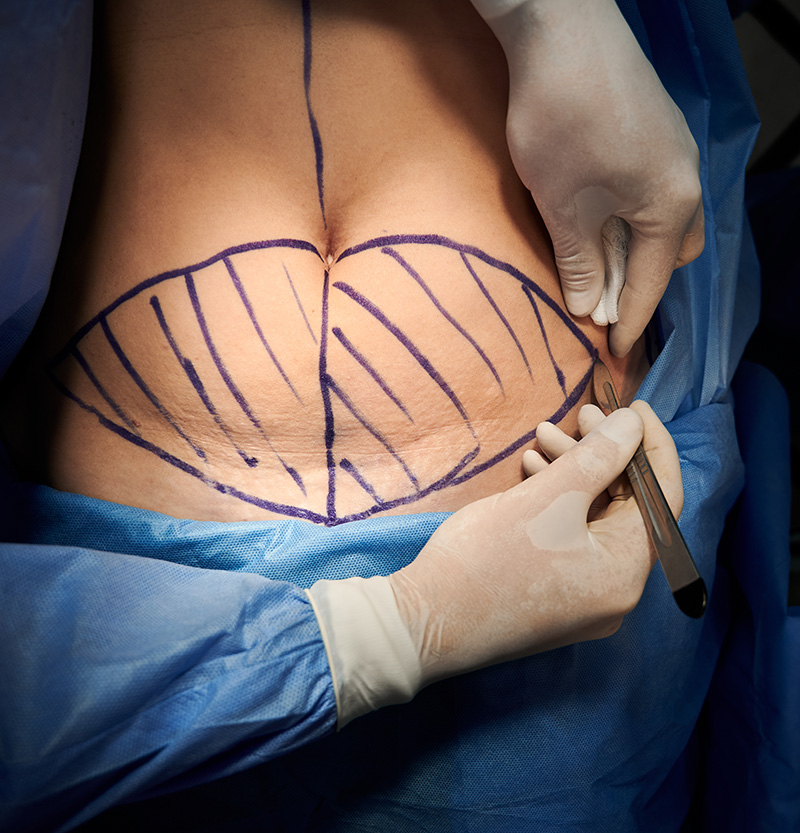What is a tummy tuck?
A tummy tuck removes excess skin and tightens the abdominal muscles, which liposuction cannot do.
People who undergo abdominoplasty are often those who have lost a significant amount of weight or after pregnancy, when the skin has become very loose and hangs down. After pregnancy, it is common for a specific muscle in the abdomen (called the rectus abdominis muscle) to become stretched and separated, giving the abdomen a rounded appearance. The separation of the abdominal muscles is called diastasis.
Abdominoplasty involves making an incision in the lower abdomen, just above the pubic area, which usually extends horizontally across the entire width of the abdomen. The scar is usually longer than 30 cm, but if it is well placed, it can be hidden by a swimsuit or underwear. Using the right techniques, a skilled surgeon can position the scar at this level. Stretch marks and old scars can be removed by excising the excess skin. In the case of diastasis, or separation of the rectus abdominis muscles by at least 2 cm, this is repaired by suturing them together. The navel is also repositioned during abdominoplasty.
Abdominoplasty always requires an overnight stay in hospital. Most patients can return to office work 3 weeks after the procedure. Drains are usually removed 24 hours after the procedure.
A tummy tuck often includes liposuction (which is not the case in the opposite situation: liposuction rarely includes a tummy tuck) to target excess fat in the abdomen and love handles.
In the case of a tummy tuck, we always use general anaesthesia, unlike liposuction, where we generally use deep sedation or local anaesthesia.
What is liposuction?
Liposuction is only intended to remove excess fat. Unlike abdominoplasty, it does not involve tightening the skin by removing it or firming the abdominal muscles.
Patients often resort to liposuction when they have excess fat but the skin on their abdomen is already quite tight.
During the procedure, a cannula is inserted through small incisions and used to suction out the targeted areas of fat. The incisions are made in hidden areas that allow access to the targeted areas and are only about 4 mm long.
Liposuction is always performed on an outpatient basis. Most patients can return to office work within a few days. However, you should not resume physical work for the first two weeks after the operation.
Your lifestyle has an influence on the long-term success of liposuction. The results of liposuction are considered permanent because once the fat is removed, the fat cells are gone for good. However, if you gain weight in the future, the remaining fat cells in the treated areas will absorb the fat and increase in size.
In the case of liposuction, we can perform the procedure under local anaesthetic or deep sedation. General anaesthetic is rarely used. This is unlike abdominoplasty.
The main differences between a tummy tuck and liposuction of the abdomen
Essentially, a tummy tuck is a procedure that removes excess skin and can treat the abdominal muscles, and may also include liposuction to remove areas of fat. Tummy tuck liposuction as a single procedure can only target areas of fat but cannot tighten the skin.
As discussed above, the incisions made during tummy tuck surgery are much shorter and are almost invisible one year after the procedure. Tummy tuck surgery will often leave a scar that is more than 30 cm long. Liposuction is considered less invasive than tummy tuck surgery and recovery time is shorter. For people with significant skin laxity, liposuction alone may leave more excess skin, as the skin does not necessarily tighten in the treated area after the fat is removed. For patients with moderate skin laxity, a technique called renuvion can be used, which does not require a large scar.
Choosing between the two procedures
Ultimately, the choice between a tummy tuck and liposuction depends on what you want to achieve.
If you have loose skin in the abdomen and want to treat excess skin, or if you suffer from diastasis recti, a tummy tuck will be more appropriate.
A tummy tuck can sometimes include liposuction of the stomach to treat excess fat pockets as well as excess skin and separated muscles. You can therefore combine these two procedures instead of choosing between them.
However, if you only want to target stubborn areas of fat in the abdomen and your skin is sufficiently elastic in this area, meaning that it will probably remain sufficiently firm after the excess fat has been removed, tummy tuck liposuction may be the most appropriate procedure . In cases where the skin is moderately loose, abdominoplasty may not be necessary and the skin can be tightened using a treatment called Renuvion.
The combination of different procedures allows us to offer you a tailor-made solution, adapted to the specific needs and objectives of each patient. In all cases, a consultation at the Bellefontaine Clinic will be necessary to decide which option is best for you. I hope you found this article useful!




